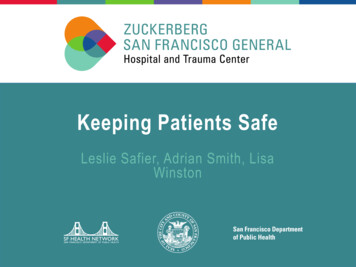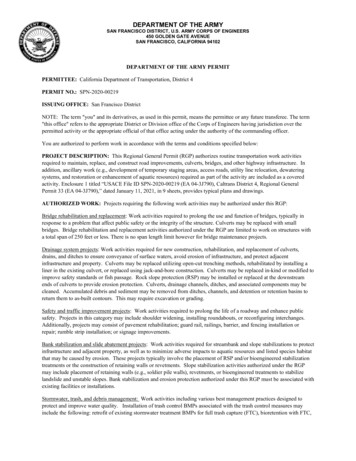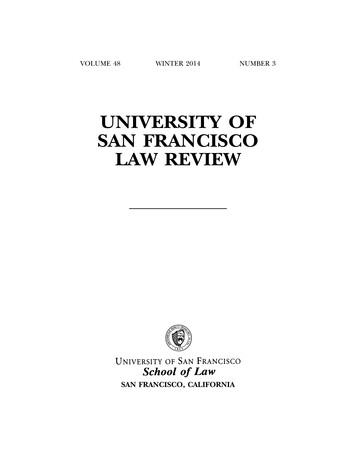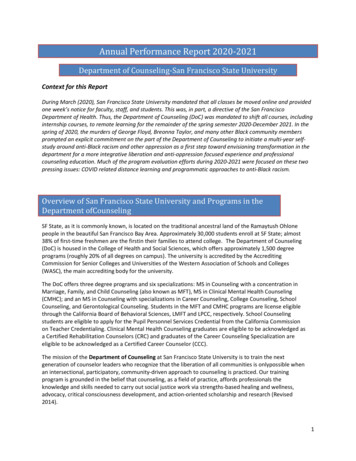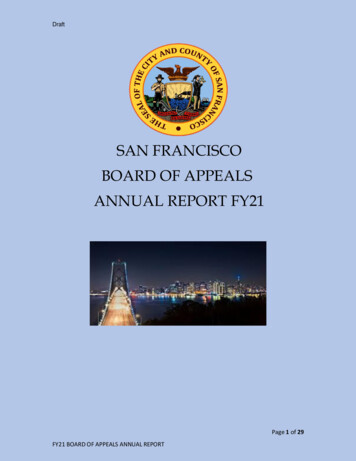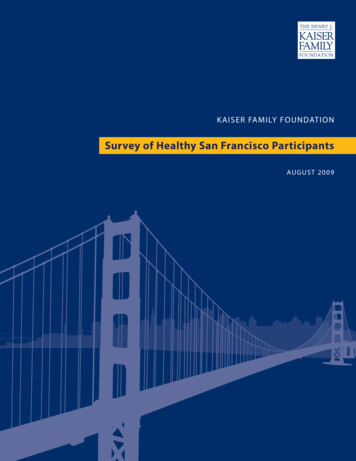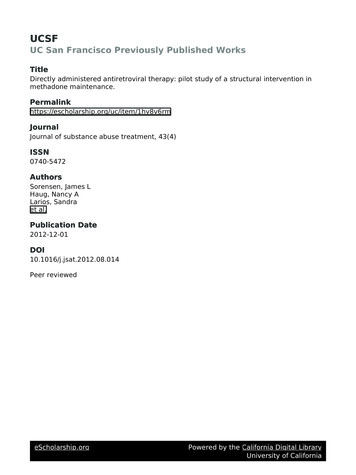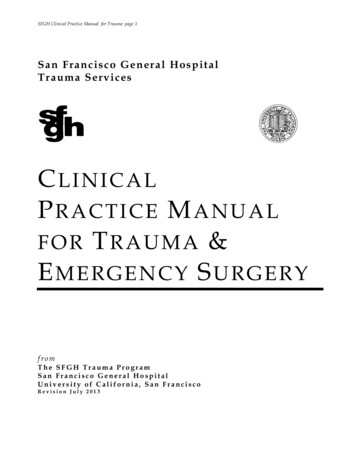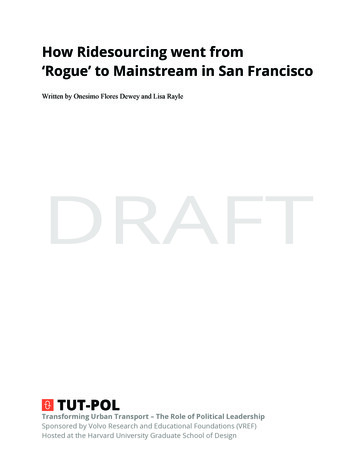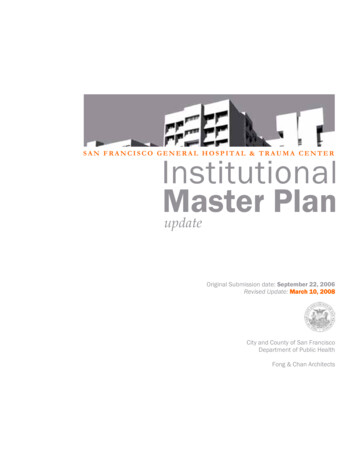
Transcription
SAN FRANCISCO GENERAL HOSPITAL & TRAUMA CENTERInstitutionalMasterPlanupdateOriginal Submission date: September 22, 2006Revised Update: March 10, 2008City and County of San FranciscoDepartment of Public HealthFong & Chan Architects
Table of ContentsSection 1IntroductionPurpose of the IMPSection 2Institutional OverviewStatement of Institutional Goals and ObjectivesServices ProvidedAmbulatory ServicesEmergency ServicesDiagnostic Services & Ancillary ServicesAcademics & ResearchPopulation CharacteristicsPatientsEmployeesAffirmative Action ProgramsHistory of GrowthSection 3Facilities OverviewCampus DescriptionHistoryCampus BuildingsSurrounding Land UseTransportation ConditionsTrafficParkingTransitPedestrian ConditionsBicycle ConditionsSection 4Development ObjectivesMedical HelipadBackgroundProject DescriptionNew Emergency Generator CapacityBackgroundProject DescriptionNew Acute Care HospitalSan Francisco General Hospital Medical Center Institutional Master Plan Update – September 2006
Section 5General Plan ConformityPlan Development Conformity with General Plan ElementsDescription of General Plan ElementsProject DescriptionMedical HelipadNew Emergency Generator CapacityNew Acute Care HospitalPlan Development Conformity with Eight Priority PoliciesSection 6Environmental ConditionsAnticipated Impacts on the Surrounding NeighborhoodsMedical HelipadNew Emergency Generator CapacityNew Acute Care HospitalIdentification of any Alternatives to Lessen or Avoid AdverseImpacts Upon the Surrounding NeighborhoodMedical HelipadNew Emergency Generator CapacityNew Acute Care HospitalIdentification of Mitigating Actions to Lessen Adverse Impacts onthe Surrounding NeighborhoodMedical HelipadNew Emergency Generator CapacityNew Acute Care HospitalSection 7ReferencesSan Francisco General Hospital Medical Center Institutional Master Plan Update – September 2006
Section 1IntroductionThe San Francisco General Hospital & Trauma Center (SFGH&TC)submits this Institutional Master Plan (IMP) to update the September2006 IMP Update with a revision dated March 2008 currently on filewith the Planning Department. Items in bold type indicate a revisionto an existing section of the document.Items with an orange bar indicate a completely new section added tothe document.Fig. 1-1SFGH&TC as seen from McKinley Square ParkSince 1987, there have been several modest developments on theSFGH&TC campus; these are described in sections 2 and 3 of this IMPUpdate. The remaining sections will present summary informationregarding the following three future plan developments: Medical Helipad New Emergency Generator Capacity New Acute Care HospitalSFGH&TC, under the mandate of Senate Bill 1953, is obligated toinsure its acute care building meets established seismic standards by2013. As a result of detailed planning analysis performed in 2004, ithas been determined that retrofitting the existing acute care buildingwould be intrusive, challenging for the hospital to remain in operationduring construction, reduces available space, and that construction ofa new acute care hospital facility is required; planning for which is stillin development.A full IMP that reflects all proposed plan developments and theirimpacts, will be prepared and submitted separately from this update.Owing to the time that will elapse before definite planning for the newhospital will be completed, this update has been prepared for theinterim.The hospital would also like to continue the dialogue and participationwith the neighboring communities and the City and County of SanFrancisco regarding future measures and programs for thedevelopment and growth of SFGH&TC.San Francisco General Hospital & Trauma Center Institutional Master Plan Update – September 2006 (Rev. 3/08)1-1
Section 1 IntroductionPURPOSE OF THE INSTITUTIONAL MASTER PLANThe IMP serves to advise the Commission and the public of long-rangedevelopment projects proposed by SFGH&TC; according to the threeprincipal purposes set in Section 304.5 of the San Francisco PlanningCode:A“To provide notice and information to the Planning Commission,community and neighborhood organizations, other public andprivate agencies and the general public as to the plans of eachaffected institution at an early stage, and to give an opportunityfor early and meaningful involvement of these groups in suchplans prior to substantial investment in property acquisition orbuilding design by the institution.”B“To enable the institution to make modifications to its masterplan in response to comments made in public hearings prior to itsmore detailed planning and prior to any request for authorizationby the City of new development proposed in the master plan.”C“To provide the Planning Commission, community andneighborhood organizations, other public and private agencies,the general public, and other institutions with information thatmay help guide their decisions with regard to use of, andinvestment in, land in the vicinity of the institution, provision ofpublic services, and particularly the planning of similarinstitutions in order to insure that costly duplication of facilitiesdoes not occur.Furthermore, its purpose is to identify the impacts of thesedevelopments to the City’s Master Plan and to the adjacentneighborhood(s); and also to identify alternative development.11Guideline for Applications for Institutional Master Plans,November 2002, p.1San Francisco General Hospital & Trauma Center Institutional Master Plan Update – September 2006 (Rev. 3/081-2
Section 2Institutional OverviewOverview San Francisco General Hospital & Trauma Center(SFGH&TC) is a general acute care hospital within the CommunityHealth Network, which is owned and operated by the City and Countyof San Francisco, Department of Public Health.During its 150 year history, the San Francisco County Hospital, laterto be renamed San Francisco General Hospital & Trauma Center, hasbeen providing humanistic, cost-effective, and culturally competenthealth services to the residents of the City and County of SanFrancisco. SFGH&TC provides health care services to vulnerablepopulations in San Francisco, including the uninsured, homeless,children, elderly, low-income, and racial and ethnic minorities.SFGH&TC is one of two acute care hospitals serving the southeastsection of San Francisco; Saint Luke’s Hospital, located at 3555Cesar Chavez Street, also serves the southeast quadrant of the Cityand is one of California Pacific Medical Center’s four campuses.SFGH&TC provides services to local residents.Around 50% of the patients treated at the SFGH&TC reside in thearea. SFGH&TC serves as a safety net for the uninsured and thehomeless. Less than 2% of SFGH&TC‘s patients have commercialinsurance coverage, 7% were homeless, or on the street at the timeof service. Approximately 85% of the patient population eitherreceives health care services subsidized by government programssuch as Medicare or Medical or are uninsured.Fig. 2-1Aerial View of SFGH&TC1915Since its establishment in 1854, providing care to 400 sick peoplethat year, the Hospital has evolved into a major-academic tertiarycare medical center. SFGH&TC is the only hospital in the City andCounty to operate a Trauma Center (Level 1) for 1.5 million residentsof San Francisco and northern San Mateo County. SFGH&TC also hasa full complement of mental health care from psychiatric emergencyservices to in-patient psychiatric care and rehabilitation and posthospitalization care. SFGH&TC has gradually expanded andmodernized its hospital facilities, providing the community with acomplete range of emergency, trauma, inpatient, primary care,specialized medical and surgical services, diagnostic andrehabilitation services.SFGH&TC has a long history and strong commitment to healthcareeducation; physician, nurse and health worker training; and medicalresearch. It takes pride in its longtime affiliation, since 1884, withthe University of California, San Francisco serving as a majorteaching hospital and home to a number of prominent researchcenters and institutes.San Francisco General Hospital & Trauma Center Institutional Master Plan Update – Revision March 20082-1
Section 2 Institutional OverviewIn the most recent development for the future of SFGH&TC, the SanFrancisco Health Commission passed a resolution in January 2004,supporting the rebuild of the acute care facility.Fig. 2-2View of San Francisco General HospitalCampus from the southwest.STATEMENTS OF INSTITUTIONAL GOALS AND OBJECTIVESSFGH&TC Mission: To provide quality healthcare and trauma servicewith compassion and respect and to deliver humanistic, costeffective, and culturally competent health services as an integral partof the Department of Public Health for the City and County of SanFrancisco by: Providing access to all residents by eliminating financial,linguistic, physical and operational barriers; Providing quality services that treat illness, promoting andsustaining wellness, and preventing the spread of disease, injuryand disability; Participating in and supporting training and research; and Serving the healthcare needs of the community.Vision Statement: Rebuild SFGH&TC so we can continue to providehealthcare and trauma services for people in need. “To be the BestPublic Hospital in the Country.”Value Statement: To promote access to services, quality of care,patient safety, customer satisfaction, staff morale, resourceSan Francisco General Hospital & Trauma Center Institutional Master Plan Update – September 2006 (Rev. 3/08)2-2
Section 2 Institutional Overviewmanagement, effective partnerships, and academic excellence. Patient and staff safetyQuality healthcareDisease preventionStaff retention and recruitmentCulturally responsive careEfficient resource managementAcademic excellence in training and researchGoals 2007-2008: Promote patient safety Implement healthy San Francisco Promote organizational and staff cultural responsiveness Promote staff retention & recruitment Improve hospital infrastructure Plan a replacement hospital Comply with all regulatory standards and performanceimprovement initiativesSERVICES PROVIDEDSince its inception, SFGH&TC has served as a community hospitalwith its primary goal to provide all San Franciscans with qualitymedical services. After overcoming several crises and problems inthe early 20th century, SFGH&TC today is a licensed 539 bedgeneral acute care hospital, providing a full complement of inpatient,outpatient, emergency, skilled nursing, diagnostic, behavioral healthand rehabilitation services for adults and children. This includes 403acute care beds, 106 psychiatric beds, and 30 skilled nursing levelbeds.Clinical Service Groups at SFGH&TC : Anesthesiology Neurology Cardiology Neurosurgery Dermatology Normal Newborns Emergency Medicine Obstetrics Family Medicine Oncology Gastroenterology Ophthalmology General Surgery Orthopedic Gynecology Otolaryngology Hematology Pediatrics HIV Infection Psychiatry Internal Medicine Pulmonary Interventional Radiology Rehabilitation Medicine Laboratory Medicine Substance Abuse Maxilo-Facial/Plastic Surgery Trauma Neonatology UrologySan Francisco General Hospital & Trauma Center Institutional Master Plan Update – September 2006 (Rev. 3/08)2-3
Section 2 Institutional Overview Nephrology Vascular SurgeryThe services provided at SFGH&TC are grouped into the followingmajor categories: Fig. 2-310,173 skilled nursing days were provided inthe year of 2006-2007Diagnostic ServicesInpatient ServicesAmbulatory Services (Primary & Specialty Care)Emergency ServicesTrauma ServicesWithin each of these categories is a broad range of services, whichdefine the complex level of care provided at the Hospital.INPATIENT SERVICESCurrently SFGH&TC is licensed for 403 general acute beds, 106acute psychiatric beds, and 30 Skilled Nursing beds. It is the largestprovider of acute psychiatric care in San FranciscoIn Fiscal Year 2006-2007, there were 16,209 acute admissions, ofwhich 16% were acute psychiatric. There were 109,959 patient daysof which 27% were acute psychiatric. The ten most frequentlyoccurring acute inpatient diagnoses were: Newborn ongestive Heart Failure Depressive DisorderHIV DiseaseParanoid SchizophreniaAlcohol WithdrawalLeg CellulitesSFGH&TC maintains a 30 bed short-term Medical/Surgical SkilledNursing unit. This unit provides short-term non-acute care forpatients awaiting or recovering from a procedure, patients requiringaftercare that is unable to be administered at home, and patientsawaiting placement. Average length of stay is 26 days.San Francisco Behavioral Health Center In addition, SFGH&TC ishome to the San Francisco Behavioral Health Center (SFBHC). SFBHCserves the sub-acute psychiatric population of the City and County ofSan Francisco, providing diagnostic evaluation and treatmentservices, with a rehabilitation focus that promotes improvedindependence and enables residents to achieve their highest level offunctioning, for residents with severe and persistent mental illness.The SFBHC is designed to help residents move along the continuumof care and to transition to the most appropriate community setting.SFBHC has three level of care: Mental Health Rehabilitation: licensed by the CaliforniaDepartment of Mental Health (DMH), the Mental HealthSan Francisco General Hospital & Trauma Center Institutional Master Plan Update – September 2006 (Rev. 3/08)2-4
Section 2 Institutional OverviewRehabilitation Program has 47 beds and focuses onpsychosocial rehabilitation of clients with severe and persistentmental illness. Skilled Nursing Facility: licensed by the Department of HealthServices (DHS), the Skilled Nursing Facility has 59 beds andprovides for continued care of psychiatric patients withmedically complex needs.Fig. 2-4San Francisco General Hospital Clinic Entrance94,266 outpatient admissions were registeredin the year of 2006-2007 Adult Residential Care Facility: licensed under the CaliforniaDepartment of Social Services’ (DSS) Community CareLicensing Division, the Adult Residential Care Facility has 41beds and helps clients transition back into their community.AMBULATORY SERVICESIn Fiscal Year 2006-2007, over 94,000 people were treated in thehospital’s clinics. 506,150 visits were documented, of which 25%were primary care, 28% were specialty care and 4% were urgentcare. Ambulatory clinic services are organized and provided under 6major centers:Adult Medical CenterThe Adult Medical Center providescomprehensive primary care services through its General MedicineClinic and specialty services to persons over 18 years of age.Specialties services include: Hepatomegaly tensionAdult Surgery Center The Adult Surgery Center provides a full-rangeof ambulatory surgical specialties, where comprehensiveconsultation, surgical procedures and recovery are provided in thehospital setting. Surgical Specialty Services includes: TraumaGeneral FootBreast osurgeryOptometryUrologyOral SurgeryChildren’s Health Center The Children’s Health Center providesSan Francisco General Hospital & Trauma Center Institutional Master Plan Update – September 2006 (Rev. 3/08)2-5
Section 2 Institutional Overviewculturally competent and sensitive medical services to children andyoung people up to the age of 21. It serves children requiringevaluation of health status, diagnosis and treatment of acute illness.In addition to primary and specialty care services, off-hours pediatricurgent care services are available for patients of the CommunityHealth Network and its affiliated partners.Specialty services include: Asthma Dermatology Cardiac Urology HematologyRenalNeurologyNutritionWomen’s Health CenterThe Women’s Health Center providesgeneral obstetrical and primary women’s health care for women ofadolescent to geriatric age.Specialty services include: Infertility treatment Prenatal education and exercise programs Teen obstetrics programsExtensive family planning services, including therapeutic abortions,and counseling services are provided within the Family PlanningClinic.Family Health CenterThe Family Health Center providescomprehensive primary care to all family members of all ages,including culturally competent care for the diverse population of thecommunity served by SFGH&TC. Using a Family Practice model, staffincorporates patient education, counseling, diagnostic, screeningand therapeutic services in the patients’ care and emphasis is onprevention, health maintenance and early diagnosis and treatment ofillness.Services include: Prenatal care Perinatal case management Well child care Pharmacist consultation Mental health services Nutritional assessment and education Substance abuse counseling Family therapy HIV family clinic Social services Minor surgery Health education Diabetes education and case managementSan Francisco General Hospital & Trauma Center Institutional Master Plan Update – September 2006 (Rev. 3/08)2-6
Section 2 Institutional OverviewPositive Health Program The Positive Health Program is a multidisciplinary service that provides specialized care to HIV-infectedpatients. The program delivers compassionate care with a focus oncontinuity and quality provided by an enabled, committed, expertstaff. Research is focused to improve care, and maintain adequateresources for meeting the care demands of its service population.Fig. 2-529% of all ambulance traffic in San Franciscois received by the SFGH&TC Emergency andTrauma CenterServices include: Primary Care Dermatology Pulmonary Endocrinology Neurology Mental health servicesLymphomaWomen’s HealthOncologyHealth educationEMERGENCY SERVICESThe SFGH&TC Emergency Department (ED) is a 24-hour, 7-day aweek service licensed by the State of California for comprehensiveemergency services. The ED provides resuscitation care for theTrauma Center (Level 1) and is the primary receiving facility for masscasualties’ events. In Fiscal Year 2006-2007, over 53,000Emergency Room visits occurred, of which 22% resulted in anadmission.Psychiatry Emergency Services (PES) provides 24-hour, 7-day aweek emergency assessment, stabilization and disposition for acutepsychiatric patients. Last year, over 7,700 people were treated, ofwhich 25% were admitted.Trauma Program The SFGH&TC Trauma Center was one of the firstprograms organized in the United States to combat death anddisability due to injury. It has also been designated as the Level ITrauma Center for both adults and children by the EmergencyMedical Service Agency [EMSA] of both San Francisco and SanMateo Counties.A designated Trauma Center (Level 1) is defined as a specializedhospital facility that has an adequate depth of personnel, resources,services, equipment and supplies to provide care for the injuredpatient throughout all phases of the patient’s care from resuscitationthrough discharge. This continuum of care includes the EmergencyDepartment, Radiology/Imaging Services, Laboratory and BloodBank, Operating Room, Intensive Care Nursing, Medical-SurgicalNursing, Physical Therapy, Social Services and psychological supportfor the patient and family. This level of comprehensive care isimmediately available 24 hours/day every day of the year.San Francisco General Hospital & Trauma Center Institutional Master Plan Update – September 2006 (Rev. 3/08)2-7
Section 2 Institutional OverviewAs San Francisco’s only Trauma Center SFGH&TC providesresuscitation, diagnosis, treatment and rehabilitation for complexinjuries affecting all areas of the human body. Approximately 3,300adults and children are treated each year for injuries requiringactivation of a multi-disciplinary team of surgeons, nurses,technicians and therapists.Fig. 2-6Every year 2,500,000 doses of medication aredispensedPoison Control Center SFGH&TC is the home for the Poison ControlCenter in northern California, where information about poisoningsand treatment is provided around the clock to healthcare providersand the general public over a telephone network.Urgent Care The Adult Urgent Care Service provides evaluation andtreatment to patients with non-emergent conditions, who, in the past,were diagnosed and treated in the Emergency Department. The clinicis open 7 days per week including holidays for 80 hours of servicecoverage. Adult Urgent Care documented over 21,800 medicalencounters in the year 2006-2007.DIAGNOSTIC SERVICES & ANCILLARY SERVICESFig. 2-7Around 200 clinical nursing placements forstudents from California State ties and colleges are offered eachyear. Clinical LaboratoriesFood and NutritionInfection ControlNursingPastoral CareRehabilitationRespiratory TherapyPharmaceuticalMedical/Psychiatric SocialRadiologyInterpreterMaterial ManagementMessengersMedical Staff OfficeParkingPatient/Visitor CenterUtilization Management AdmittingBiomedical EngineeringBusinessEducation and TrainingEnvironmentalFacilities ManagementHuman ResourcesHealth and SafetyHospital AdministrationHealth Information SystemInformation SystemQuality ManagementRisk EMICS AND RESEARCHThe UCSF Dean’s Office is confirming the number of principalinvestigators conducting research on the hospital campus. Throughits long-standing affiliation with the University of California, SanFrancisco (UCSF), SFGH&TC serves as a major teaching hospital forMedicine, Nursing, Pharmacy and Dentistry. All of the physicians atSan Francisco General Hospital & Trauma Center Institutional Master Plan Update – September 2006 (Rev. 3/08)2-8
Section 2 Institutional OverviewSFGH&TC are UCSF faculty. Approximately 1,400 UCSF physicians,specialty nurses, health care professionals and other professionalswork side-by-side with 3,000 City employees at SFGH&TC. The Cityand County Of San Francisco pays UCSF for the patient care servicesthrough an affiliation agreement. Each year, over 350 third or fourthyear medical students, 800 residents and 60 clinical fellows aretrained at SFGH&TC. Thirty-two percent of all the UCSF internstraining, in 17 academic departments, and 35% of all UCSF medicalstudents’ clinical training are conducted at SFGH&TC.Fig. 2-8Over 160 UCSF principal investigators conductresearch through programs based at SFGHMCIn addition SFGH&TC provides approximately 200 clinical nursingplacements at the Associate, Baccalaureate and Masters level forstudents from UCSF, the California State University System,community colleges, and Bay Area private universities and collegeseach year.The hospital is also home to more than 20 research centers andmajor laboratories. Over 160 principal investigators conductresearch through programs based at the hospital campus.Research work and studies in the following areas are currently beingcarried out at the SFGH&TC :Trauma related research: Rapid response improvement Emergency Department Management Violence Prevention Surgical techniques and Wound Care Brain Spinal Cord Injury Management Bone regeneration.Bioterrorism and Mass Casualty: Development of Treatment for Botulism Toxin Decontamination methods for exposures Drug and Antibody Delivery Systems Predictive models of needed resources.AIDS related research: Treatment to the homeless Adherence to treatment Outcomes in the urban poor Treatment and prevention of Drug Resistant HIV Immunology of AIDS Drug Trials Management of Illness to preserve productivity Reducing sexual risk behavior Post exposure prophylaxis (needle stick, prenatal, sexual, etc.)Cancer related research: Treatment of MesotheliomaSan Francisco General Hospital & Trauma Center Institutional Master Plan Update – September 2006 (Rev. 3/08)2-9
Section 2 Institutional Overview Medical Marijuana useBreast cancer treatment and preventionsOvarian Cancer Drug Delivery SystemPrevention of Basal Cell CarcinomasCardiovascular related research: Heart attack prevention and treatment Stroke prevention and treatment Vascular malformations and aneurysms prevention and treatmentPulmonary related research: Asthma-treatment, prevention, and genetics Interstitial lung disease-management and causes Chronic Lung Disease-pathology and preventions TB-prevention, control, and treatment Pneumonia-genetic risk factors, treatment.Health Disparities: Racial and Ethnic Disparities in adults, children and newborns Genetic Differences Health Care Delivery Systems, Literacy and Cultural Effects Comparisons of the SFGH&TC system to other systems.San Francisco General Hospital & Trauma Center Institutional Master Plan Update – September 2006 (Rev. 3/08)2-10
Section 2 Institutional OverviewPOPULATION CHARACTERISTICSThe following tables and maps show the population characteristicsfor the year 2005 in comparison with the last IMP in 1987 or withfigures available for recent years.PATIENTSGender / Race / Age The total number of all SFGH&TC patients Inthe fiscal year of 2006-2007 was 98,244 with the followingpercentage regarding gender, race and age compared to 1992.GenderFemaleMaleFY 2004 - 2005FY 2006 – 200743%49%57%51%RaceCaucasianAfrican AmericanHispanicNative AmericanAsian/Pacific IslanderOther /UnknownFY 2004 - 200527%24%29%0%15%5%FY 2006 – 200724%19%29%1%20%7%Age0-1718-4445-64Over 64FY 2004 - 200520%55%18%6%FY 2006 – 200714%46%32%8%Patient’s origins by zip code SFGH&TC plays a vital role inproviding quality health care services to San Francisco’s vulnerablepopulations, which include the uninsured, homeless, children, frailelderly, low-income, racial and ethnic minorities, and persons fromlow-income neighborhoods.The following maps indicate, by zip code, the origin of all inpatients in2006-2007 (Fig.2-9) and all patients in 2006-2007 (Fig.2-10)treated at the SFGH&TC.San Francisco General Hospital & Trauma Center Institutional Master Plan Update – September 2006 (Rev. 3/08)2-11
Section 2 Institutional Overview0–2%2–4%5–7%8 -10 %11 – 12 %DistrictMissionHunters PointOuter MissionNorth of MarketSouth of MarketVisitacion ValleyCivic CenterParksidePotrero HillWestern AdditionWestern AdditionOtherZip Code12% 941109% 941249% 941127% 941027% 941035% 941344% 941093% 941162% 941072% 941152% 941171%0–2%2–4%5–7%8 -10 %11 – 12 7941039411294107941149411094116941319412794132Fig. 2-9Percent of SFGH&TC Inpatients by zip code ofresidence in the year of 2006-200713% are homeless9412394129941249413494112San Francisco General Hospital & Trauma Center94123941299413394108 ictMissionHunters PointOuter MissionNorth of MarketSouth of MarketVisitacion ValleyCivic CenterParksidePotrero HillWestern AdditionWestern AdditionSunset12%8%9%7%6%6%4%3%2%2%3%2%Zip 41159411794122Fig. 2-10Percent of all SFGH&TC Patients by zip code ofresidence in the year of 2006-20077% are 1249411294134San Francisco General Hospital & Trauma CenterSan Francisco General Hospital & Trauma Center Institutional Master Plan Update – September 2006 (Rev. 3/08)2-12
Section 2 Institutional OverviewSources of Patient Revenue The following table shows the currentactivities by payer type for fiscal year FY 2006-2007.Payer atient days28%4%34%23%8%Outpatient Encounters35%2%26%18%19%Utilization Statistics The following summary describes the hospitalactivity during the recent fiscal year of 2006-2007.Inpatient Services The number of acute patient days for the fiscal year of2006-2007 was 109,959, of which 27% were related to theacute psychiatry 16,209 acute admissions, of which 16% were to acutepsychiatry There was a total of 43,222 skilled nursing days, 84% wereat the SFBHCIn Surgery: 6,612 surgical procedures were performed in 10 operatingrooms, of which 50% were emergent. 41,089,390 surgical minutes were performedIn Obstetric/Gynecology: 1,232 babies were born at SFGH&TC Over 2,300 women received prenatal care, of which 30%were high-risk casesOutpatient Services 94,266 individuals were seen Total of 506,150 clinic visits; of which 25% were primarycare, 28% were specialty care, 4% were Urgent care visitsand 20% were diagnosticEmergency Services Over 53,000 Emergency Department visits, with 22%resulting in an admission Over 7,700 Psychiatry Emergency encounters, with 25%being admitted 29% of all ambulance traffic in San Francisco was receivedby SFGH&TC.Trauma Center 3,279 adults and children are treated for injuries requiringactivation of the trauma teamSan Francisco General Hospital & Trauma Center Institutional Master Plan Update – September 2006 (Rev. 3/08)2-13
Section 2 Institutional OverviewNumber of Discharges by Service The following table shows acomparison between 1992 and 2007 for the number of dischargesby serviceNumber of dischargesby otalFY 19924,903 – 23.00%8,072 – 37.87%1,380 –6.47%1,589 –7.45%2,058 –9.70%21,315 – 100.00%FY 20074,797 – 28%7,132 – 42%401 – 2%2,688 – 17%1,247 – 7%16,265 – 100%Licensed Beds The following table shows a comparison between1992 and 2007 for the number of licensed beds. It shows anincrease of acute psychiatric beds and 130 new skilled nursing bedsdue to the opening of the SFGH&TC Behavioral Health Center.Licensed BedsGeneral acute bedsAcute psychiatric bedsSkilled nursing bedsTotalFY 199249587-582FY 2007403106136645Average Length of Stay The following table shows a comparisonbetween 1992 and 2007 for the number of discharges by serviceAverage Length of StayMedical / SurgicalAcute CarePsychiatric Acute Car
San Francisco General Hospital & Trauma Center Institutional Master Plan Update - September 2006 (Rev. 3/08) 1-1 Section 1 Introduction The San Francisco General Hospital & Trauma Center (SFGH&TC) submits this Institutional Master Plan (IMP) to update the September 2006 IMP Update with a revision dated March 2008 currently on file
